Pico da Neblina: Trekking Brazil's Sacred Amazonian Peak with the Yanomami

In the early 16th century, respected Spanish chronicler Gonzalo Oveido described the glittering kingdom of El Dorado, whose ruler was coated in gold dust daily, and which could be found east of the Andes, in the Amazon jungle. That Oveido hadn’t been there and the Amazon is twice the size of India didn’t deter avaricious conquistadors going to plunder it. None found it, many died, but the allure of a lost Amazonian civilisation persisted. In 1925, seasoned British explorer Sir Percy Fawcett went in search of the so-called City of Z, accompanied by his 21-year-old son and a family friend. They were never seen again, and scores of aspiring rescuers disappeared too. It seems Amazonian quests typically end in despair and disaster.
It was raining so hard, I could barely see. Slithering down a muddy bank, I almost continued into a surging, chocolate torrent, some 20m wide. Attempting to ford looked suicidal. Retreat meant an eight-day wait for the boats to return. Though I wasn’t searching for lost cities or treasure, but Brazil’s highest peak, my quest looked just as doomed.
While already well-known to the indigenous Yanomami tribe, Pico da Neblina was only recently recognised as Brazil’s highest point. Deep in the Amazon jungle and typically hidden by clouds, it was ‘discovered’ in 1954 by an American botanical expedition which named it Neblina or ‘Misty Mountain’ – despite the Yanomami already calling it Yaripo or ‘Home of the Winds’. Initially thought to lie in Venezuela, a Brazilian army expedition in 1965 recorded the first ascent and more precise measurements, claiming it for Brazil. Having first been booked at over 3000m, it’s since been pared down to 2995m.
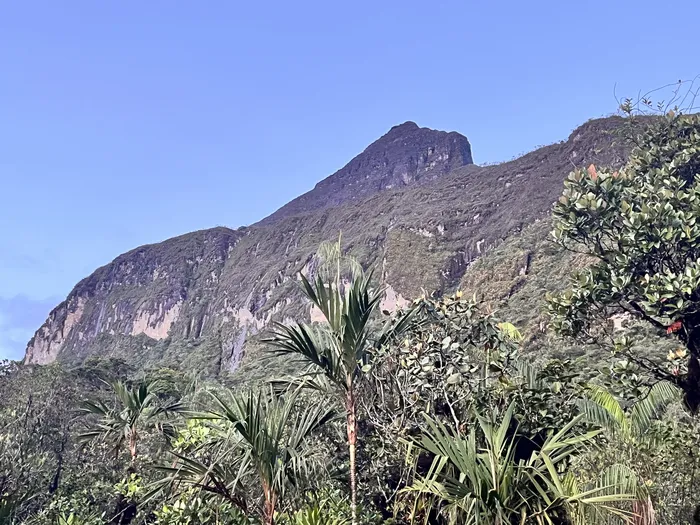
Once discovered, Neblina was increasingly frequented by peak baggers till 2002, when the Yanomami barred access, protesting the intruders were despoiling their sacred lands and not paying them enough. The mountain only reopened to visitors in late 2022, by which time I’d spent a decade arranging said trip. My only teammate, Mandy Ramsden, claimed she’d always wanted to visit the Amazon - which surprised me, because I thought she had more sense.
Our trip started in Manaus, a gritty industrial city on the Rio Negro. Ornate buildings round the town square recalled Manaus’s heyday in the late 19th century, when the rubber boom catapulted it from a muddy backwater into South America’s richest city, and ostentatious rubber barons flaunted sumptuous villas, large yachts, pet lions and racehorses watered with champagne. They also had an opera house constructed, the spectacularly incongruous Teatro Amazonas, which still dominates the city with its pink façade topped by a green and gold dome. The first performance was in 1897, half the visiting troupe died from yellow fever and two decades later the rubber boom was over.
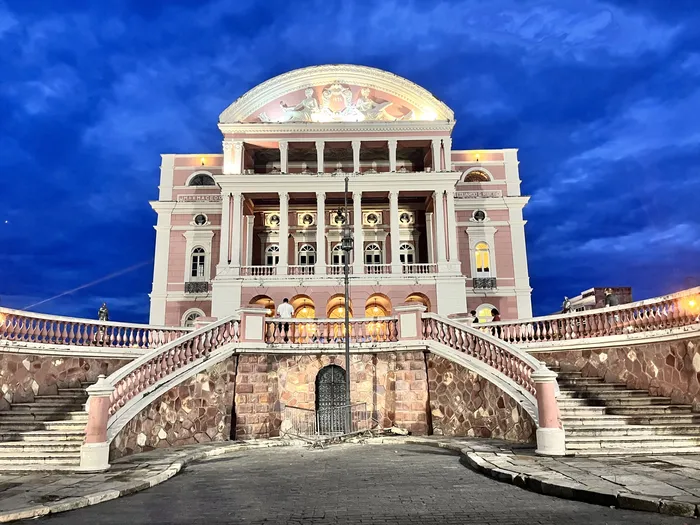
Beside the opera house and our hotel bar, Manaus’s only other attraction was ‘the Meeting of Waters’, 15km downstream, where the dark, sluggish Rio Negro joins the lighter, faster Solimoes to form the mighty Amazon. We hired a motorboat and drifted in the confluence. Due to their markedly different characters, the two rivers accompany each other side-by-side for 5km before merging.

The Amazon River acquired its name from the first expedition seeking El Dorado, in 1541, when 240 Spanish conquistadors left Quito, with 4000 slaves. By the time they’d crossed the Andes, most of them had perished and the survivors were reduced to eating their leather belts. In desperation, second-in-command Francisco de Orellana took 57 men downstream on a foraging trip, in a hastily-built boat. As the river got stronger they were unable to return. After a torrid eight-month voyage, they were flushed out into the Atlantic Ocean, having inadvertently made the river’s first descent. Along the way, they passed numerous settlements, where some tribes were hospitable, but most weren’t. Just below the Meeting of Waters, they repelled a particularly ferocious attack led by tall, pale-skinned, female archers - prompting Orellana to rename the river after the legendary Amazonian warriors in Greek myth. Still seeking treasure, Orellana returned to the Amazon four years later, only to get lost and die in the delta.
Having exhausted Manaus’s charms, we flew 850km northwest to Sao Gabriel da Cachoeira, a few minutes south of the Equator. On the Upper Rio Negro, the town boasted an attractive location, if little else. However, it was the base for our local outfitters, from whom we collected provisions. By now, we’d also picked up our guide. In his mid-fifties, and fluent in several European and indigenous languages, Sam Basilio was just the man for our trip. Brought up on his family farm, he’d worked on ships, run his own logistics company, led scientific expeditions, played in a rock band and advised on jungle survival competitions. Unflappable, he could solve most problems with his machete and the flora to hand.
Before progressing further, we had to take COVID tests, supposedly to protect the Yanomami, who’d almost been exterminated by simple European viruses to which they had no immunity. By the time we reached the clinic, Mandy was sneezing, I’d developed a sore throat, and even Sam raised an eyebrow. We were quite surprised when the nurse lowered her mask to announce we’d passed.
The next leg was an 85km drive on dirt roads in a 45-year-old Toyota Bandeirante, with an empty dashboard, no seatbelts, and a huge steering wheel that required a full turn to deviate course. Our diminutive driver hit every pothole on route, plus a dog and two-metre-long snake. Surprisingly, we were over halfway before getting a puncture.

Porto Ya-mirim was the grand name for a muddy clearing beside a creek, where our two Yanomami boatmen were waiting with their ‘voadeira’, a long, slender, metal canoe with an outboard motor. As the creek joined a bigger channel and then another, I scanned the banks for fauna, but couldn’t see anything beyond the impenetrable green wall. After one hour I was bored, within two hours had cramp, and shortly after that the outboard motor packed in. The boatmen managed to ferry glide to the bank, just above a rapid, where they hung onto branches while we gingerly disembarked. We spent the next eight hours there, waiting to be rescued, and it was dawn before we reached Maturacá under tow.
With over 1000 residents, Maturacá is one of the larger communities of Yanomami, who number about 30,000 in Brazil and Venezuela. Europeans encountering the Yanomami in the mid-17th century, described them as ferociously warlike. And even in the 1950s, half Yanomami males died violently, fighting rival clans or each other. As it was, our welcoming party wore assorted football shirts and brandished smartphones.
Our late arrival meant we had to spend that day in Maturacá, which coincided with a hunting ceremony. This involved the two tribal shamans, who were allegedly octogenarians and wore monkey-skin hats, macaw-feather armbands and skimpy Y-fronts, dancing and hollering on the village field, with regular breaks to blow pipes of hallucinogenic snuff up each other’s nostrils. Falling somewhere between comic and heroic, it reminded me of a Rolling Stones concert. The ceremony went on quite a while, but once the field had filled with warriors in warpaint, we thought it diplomatic to stay till the end.

The next morning, our retinue assembled. We had 10 helpers, which seemed somewhat excessive - but as Sam pointed out, jobs here are scarce and we needed one porter just to carry manioc. The Yanomami consume manioc in great volume and many guises; boiled, fried, grilled, baked, and even ground into powder and added to water. Most meals on our trip involved manioc, though given Yanomami delicacies include monkey, caterpillar and frog, we couldn’t complain.
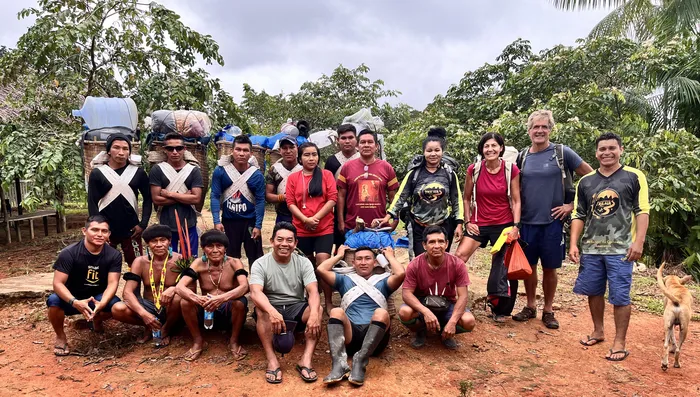
Before our expedition could get underway, the shamans theatrically blessed us, calling on the mountain spirits to protect our souls. Who knows whether the Yanomami still believe this stuff, but these two octogenarians could command any West End stage. After some further engine trouble, we departed, in two boats heading upriver, threading between strainers and whirlpools. Two hours later, we disembarked at the mouth of the Tukano River, where our porters decanted our provisions into their wicker backpacks.
A well-cut trail led through the foliage, albeit cut for someone no higher than five foot seven, which just happened to be the maximum height of a Yanomami porter. We’d barely got going before it started raining and even beneath the tree canopy we were drenched. The volume and velocity of Amazonian rain soaks you within minutes and, more alarmingly, transforms benign streams into malign spates.
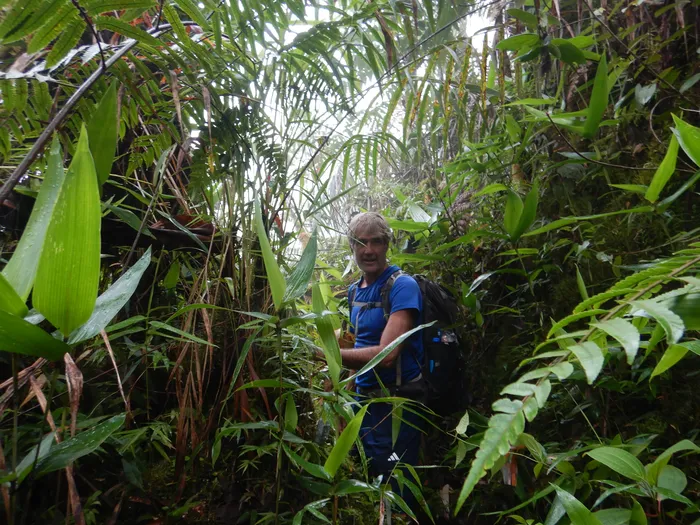
‘I don’t like the next crossing,’ frowned Sam, in a rare display of negativity, as we approached a river just short of our planned camp. Sure enough, the racing brown torrent looked to be impassable and the premature end of our trip. While Mandy and I despondently sheltered from the deluge, Sam unsheathed his machete and felled a large tree, which fell perfectly onto the far bank. Then, the porters danced across carrying our packs, and we clambered over á cheval.
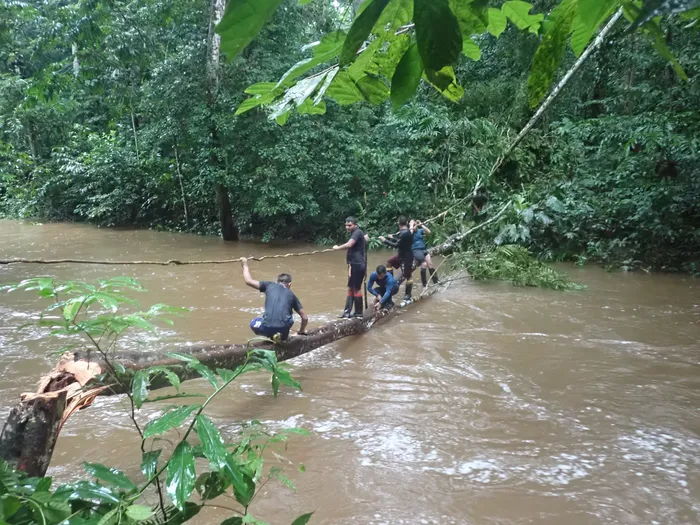
Camp comprised three open-sided, thatched-roofed shelters, plus a long drop loo which we first had to check for snakes. It was difficult to tell when it stopped raining, for water continued dripping off the tree canopy for hours. In any case, we were preoccupied swatting mosquitos, each the size of a drone. Dusk at 6.30pm saw us hastily retreat into our hammocks, for it was too perilous operating in the dark. Night was interminable: sweating, scratching, and swaying in my hammock as if on a rough voyage. Dawn eventually arrived at 6am, heralded by a racket of macaws, toucans, parrots, woodpeckers and cicadas. It was another hour, however, before it was light enough to confidently leave our hammocks and inspect our boots for scorpions. Despite having cunningly hung my pack overnight on a stick, it had been occupied by a colony of ants.
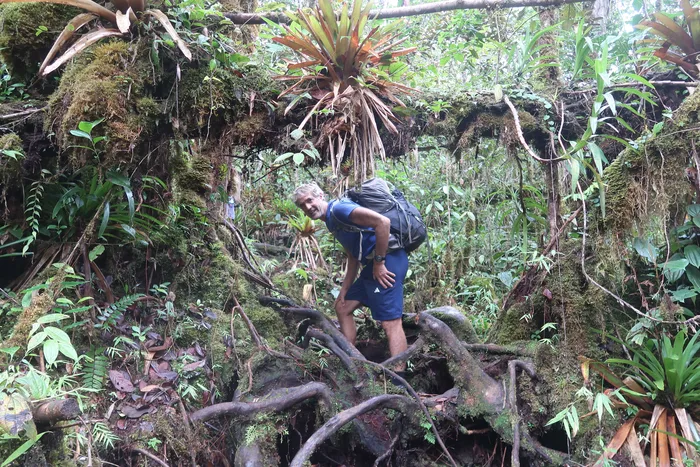
From where we’d been dropped to the peak was 35km, which took five days, so we were hardly racing. For the first three days, the trail was undulating, with little altitude gain and the main impediments were fallen trees and river crossings - when I could never banish thoughts of candiru, the translucent, toothpick-shaped catfish that swims up your most intimate orifices. As it was, however, my only close encounter was with an electric eel that flashed past my thigh.
There were also exotic creatures lurking in the foliage, though we didn’t see any, which was fine by me. The apex Amazonian reptile is the anaconda, which can stretch to nine metres and swallow a human. The apex Amazonian mammal is the jaguar, which clocks 80kph and bites through its victim's skull - though I reckoned I could outsprint Mandy. And the largest Amazonian creature is the tapir, a two-metre-long pig, which our porters hoped to shoot for the braai - but despite levelling their antique rifles at commotions in the undergrowth, nothing ever emerged.
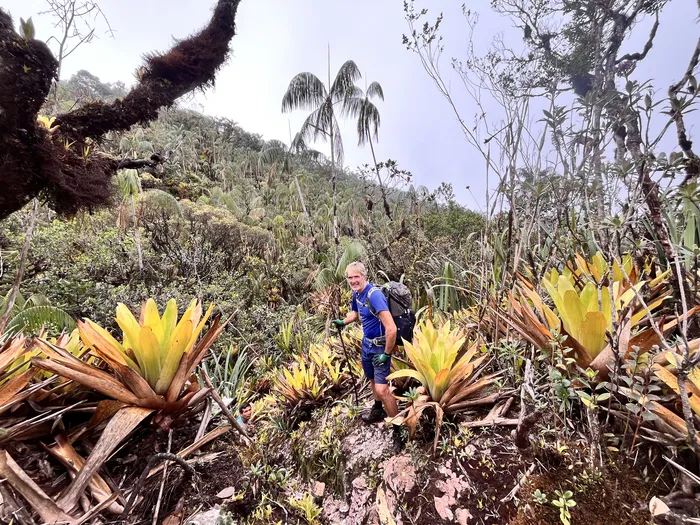
With support staff, a well-trod trail and cleared camps, we admittedly had it easier than the conquistadors and Colonel Fawcett, though it was still challenging enough for jungle numpties. It rained every day, for at least several hours. And even when it wasn’t raining, the air was so humid we still got wet. We tried drying our clothes over the campfire, which didn’t work, but left us smelling like smoked mackerel.
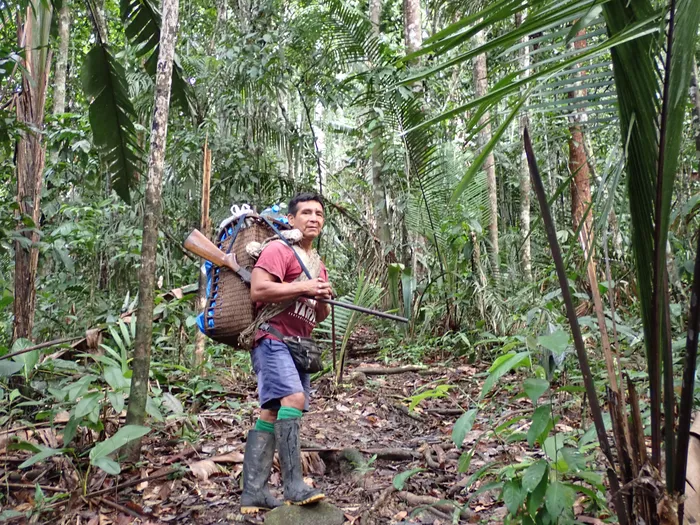
The main bugbear, however, were the insects. The Amazon is home to 2.5 million species of arthropods and most of them had a go at us, with the mosquitos by far the worst. Though our hammocks had nets, and we diligently applied every concoction of repellent, they didn’t care and just bit through our clothes. Within a few days, I had more puncture marks than a heroin addict and Mandy’s legs had erupted into volcanic fumaroles, which she gave up counting after a hundred.

No, the Amazon jungle wasn’t the Garden of Eden, nor was I the first to think so. Though it might look verdantly fertile, there’s actually little light, poor soil, too much water and too many diseases, obliging the Yanomami until recently to limit their numbers via infanticide and euthanasia. Which is why by the 1960s the prevailing view was that the Amazon was too hostile for mankind to ever evolve beyond a primitive state, and El Dorado was pure fancy.
After three days, we’d barely got off the ground or any nearer Neblina; but by the fourth the climbing became more sustained and we camped at 1600m. On the fifth day, we emerged on a large plateau at 2000m, called Serra do Imeri, which was a botanical garden on steroids. Though notionally still a trail, it was rather an obstacle course of potholes, tree trunks, boulders and mud baths, with something prickly to catch you whenever you slipped.
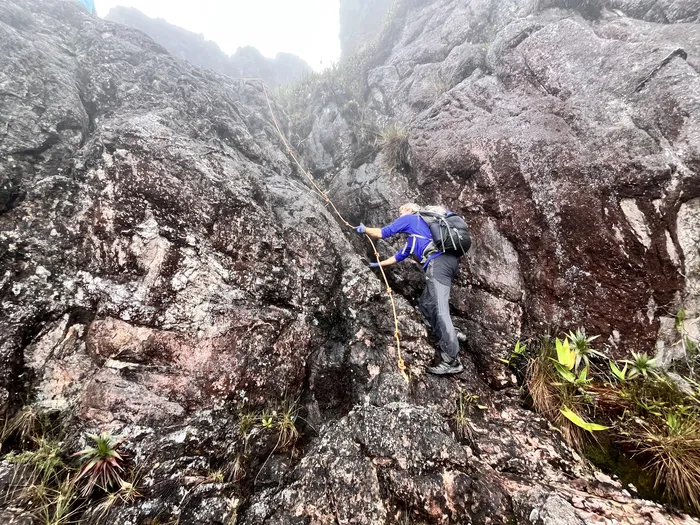
A couple of kilometres short of Neblina, our high camp was squeezed onto a small rock platform above a volatile stream and surrounded by swamp, We’d no sooner unfurled our tarpaulins than the heavens opened, and for the next two hours we huddled under them as torrential rain transformed Neblina into a water feature. Cascades swept down the flank and over the route. Unless the rain abated and the water drained off, we had no chance of summiting the following day.
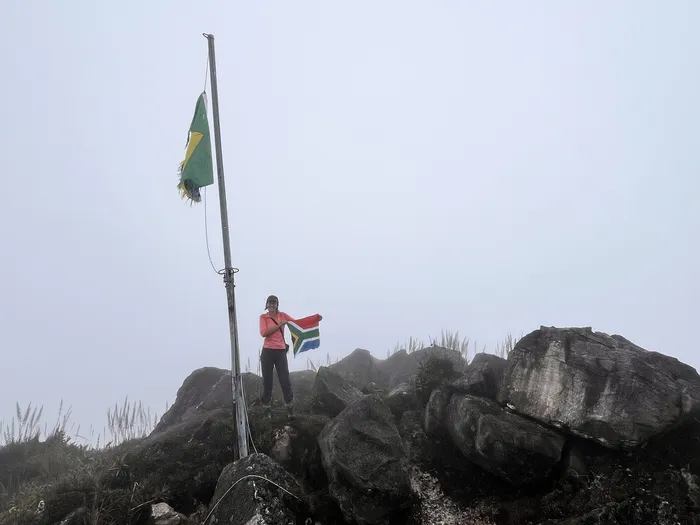
It was a long, glum night, listening to constant watery noises. So, when I dismounted my hammock at first light, I was stunned to see the sky was clear and all the waterfalls had vanished. Our summit party comprised Sam, Mandy, me, plus three crew. After a swampy start, we reached the peak’s base, from where it was an enjoyable scramble up gullies and ridges, assisted by fixed ropes and metal staples. It took three hours to the top, by which time Neblina was characteristically clagged in. Bereft of views, Brazil’s roof was an underwhelming spot, about the size of a tennis court, with a tall flagpole and tatty flag. And, of course, it then started raining.
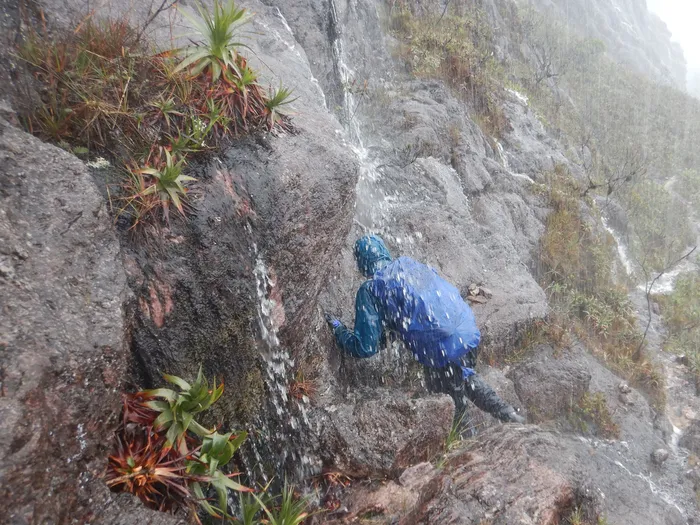
The descent was far less fun. Downclimbing ropes, we risked being drowned. Wading a sluice, we were almost washed off the flank. Crossing a swamp, we were up to our waists. And just before camp, barring our way, was a set of rapidly-swelling class three rapids. Anticipating our predicament, the porters who’d stayed behind were felling a tree, which we gratefully tiptoed across. I spent the afternoon shivering in my hammock, reflecting the mountain spirits had been on our side.
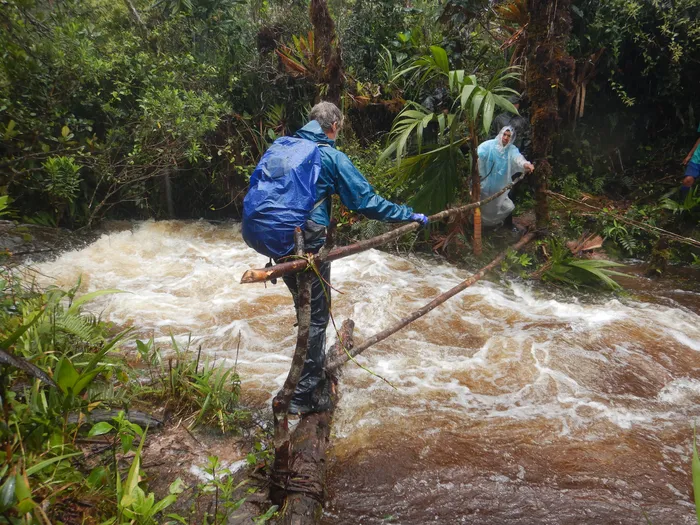
It took three days to return to Maturacá, where a funeral ceremony was in full swing. According to Yanomami rites, the bones of the deceased are cremated and made into soup to be drunk by the village. We were kept awake till dawn by the wail of the shamans lamenting the dead - though, to be fair, it was far more poignant than any rendition of ‘My Way’ and I thought about booking them for my funeral. We departed Maturacá early the next morning, lest the outboard engine failed again - which it duly did, though this time we were carrying a spare. If Sao Gabriel had seemed a dump on the way in, it was paradise on the way out, with hot showers, cold beers and, best of all, aircon.
Archaeologists recently uncovered ruins of ancient cities deep in the Amazon, with roads, plazas, monuments and fish farms – suggesting the conquistadors and Fawcett were possibly right, and the golden city of El Dorado existed. But so what: it did them no good and I’m not going back.
HELPFUL TIPS:
I arranged my Pico da Neblina trip through Southern Cross Tours & Expeditions (www.amazon-travel.brazil.com)
It runs most months, on demand, except March to June. The 18-day trip (ex Manaus) costs between US$ 6-8000pp, depending on numbers.
Recommended reading: 'The Lost City of Z' by David Grann; 'River of Darkness' by Buddy Levy.
Photos: Matthew Holt and Mandy Ramsden
Discuss this article
Clicking links may earn us commission. . Stock images by Depositphotos.
Subscribe: Stories about wildlife, habitats and heroes
Welcome to Conservation Mag where we celebrate nature preservation through ecotourism and wildlife travel while we look for ways to preserve our heritage by supporting nature conservation. Starting conversations about the positive action people like you and I are taking to make a change.
Quick Links
Work With Us
![]()

